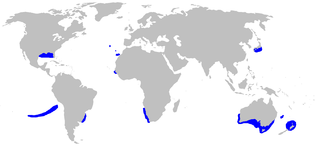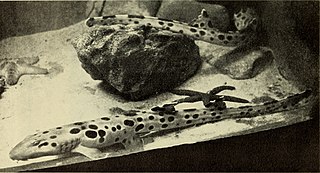
Mackerel is a common name applied to a number of different species of pelagic fish, mostly from the family Scombridae. They are found in both temperate and tropical seas, mostly living along the coast or offshore in the oceanic environment.

Herring are forage fish, mostly belonging to the family of Clupeidae.

The bareskin dogfish is a little-known, deepwater dogfish shark of the family Etmopteridae. This species is found in the western Pacific from southern Japan to western and southeastern Australia as well as in New Zealand waters.

The gummy shark, also known as the Australian smooth hound, flake, sweet william or smooth dog-shark, is a shark in the family Triakidae. These small to medium-sized bottom-dwelling sharks are found mostly in, but are not limited to, the area around the southern seas of Australia and is commonly baited and fished for cuisine because of its taste and market prices. According to a 2021 paper by White, Arunrugstichai & Naylorn (2021), Mustelus walkeri is the same animal as M. antarcticus. One theory is that M. walkeri is a subpopulation of M. antarcticus.

The crested bellowsfish or crested bellowfish, Notopogon lilliei, is a species of fish from the family Macroramphosidae. It is a demersal species which occurs over the continental shelf at depths of 80 to 600 m. They grow to lengths of up to 27 cm (11 in).

Macroramphosus, snipefishes or bellowfishes, is a genus of fishes found in tropical and subtropical oceans at depths down to 600 metres (2,000 ft). According to FishBase, they are part of the family Centriscidae, but Nelson (2016) split that family, in which case the genus Macroramphosus is in the family Macroramphosidae. They have long second spines on their dorsal fins and tiny mouths at the tip of their greatly elongated snouts. The bodies of snipefish are more streamlined than in the related bellowfishes. They reach a maximum length of about 20 cm (7.9 in), and are silvery or reddish in colour. They are sometimes found in large schools. This is the only genus on the monogeneric family Macroranphosidae but some authorities include the genera Centriscops and Notopogon in this family too.

The bellowfishes or bellowsfishes are fishes in the genus Notopogon in the family Centriscidae. They are found in deeper parts of the temperate southern oceans, although the longspine bellowfish has been recorded as far north as New Caledonia and Madagascar. According to FishBase, they are part of the family Centriscidae, but some authorities split that family, in which case the genus Notopogon is in the family Macroramphosidae, which is followed here. They have long second spines on their dorsal fins and tiny mouths at the tip of their greatly elongated snouts. Their bodies are relatively high, unlike the related snipefishes. They reach a maximum length of about 34 cm (13 in), and are silvery or reddish in colour.

The roughskin dogfish is a sleeper shark of the family Somniosidae, found around the world on continental shelves in tropical, subtropical and temperate seas, at depths of between 100 and 1,500 m. It reaches a length of 121 cm.

The blackbelly lanternshark or lucifer shark, Etmopterus lucifer, is a shark of the family Etmopteridae, found around the world in tropical to temperate seas, at depths between 150 and 1,250 meters. Its length is up to 47 centimeters. This species consumes mesopelagic cephalopods, fishes, and crustaceans.

McMillan's catshark is a catshark of the family Scyliorhinidae, in the order Carcharhiniformes. McMillan's catshark is a small, rare, and little-known deepwater shark that is endemic to New Zealand. It is found at depths of 985–1350m on the lower continental slope around New Zealand, on the West Norfolk Ridge, and off North Cape. It can grow to a length of 45 cm.

The orange bellowsfish is a species of fish of the family Macroramphosidae, found around South America, at depths of 150 to 580 m. Its length is up to 18 cm (7.1 in).

The flaccid catshark is a catshark of the family Scyliorhinidae. It is endemic to the waters around New Zealand.

The southern lanternshark is a shark of the family Etmopteridae found in the southeast Pacific between latitudes 29°S and 59°S, at depths of between 220 and 1,460 m. This species has been found off Northland, off the Chatham Islands, on the Campbell Plateau, all in New Zealand waters. Its length is up to 60 cm. Reproduction is ovoviviparous, with 10 to 13 pups in a litter, length at birth about 18 cm. They exhibit bioluminescence.

The Papuan epaulette shark, Hemiscyllium hallstromi, is a bamboo shark in the family Hemiscylliidae found around southern Papua New Guinea, between latitudes 7° S and 10° S, and longitude 144° E and 146° E. Its length is up to 75 cm.

Cavefish or cave fish is a generic term for fresh and brackish water fish adapted to life in caves and other underground habitats. Related terms are subterranean fish, troglomorphic fish, troglobitic fish, stygobitic fish, phreatic fish and hypogean fish.
Notopogon armatus is a species of fish in the family Centriscidae. This species is endemic to the central Indian Ocean, near the Ile Amsterdam and Ile St. Paul. It has been found at depths of 28–100 metres (92–328 ft). It can grow to lengths of 33 centimetres (13 in).
The Longsnout Bellowfish is a species of fish from the family Macroramphosidae. It is found in the Southeast Atlantic Ocean, from southern Namibia to Saldanha Bay in South Africa. It lives at depths from 200 to 500 metres. It grows to a maximum length of 33 centimetres (13 in).















